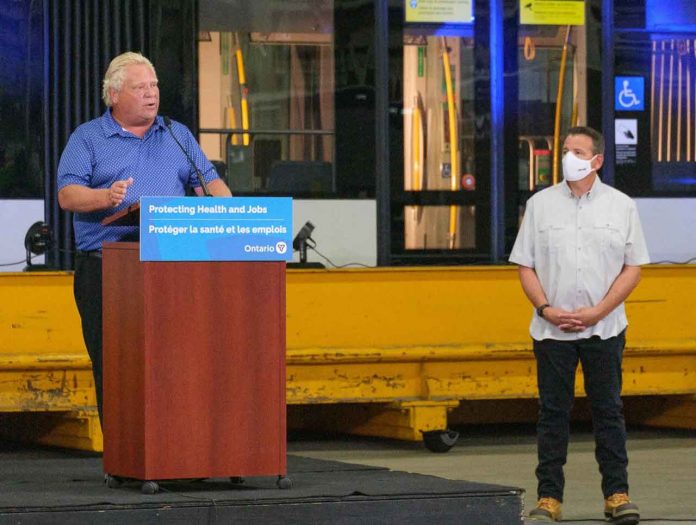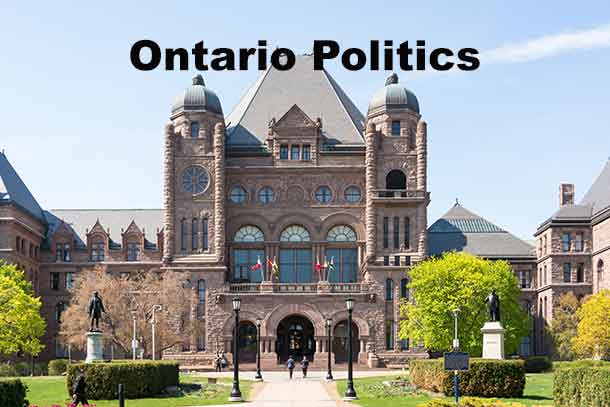QUEENS PARK – Minister of Finance Peter Bethlenfalvy released the 2021 Ontario Economic Outlook and Fiscal Review: Build Ontario. The plan lays out how the government will build the foundation for Ontario’s recovery and prosperity by getting shovels in the ground on critical infrastructure, attracting increased investment, and restoring leadership in auto manufacturing and other industries. The plan also protects Ontario’s progress against the COVID-19 pandemic.
“As we continue to protect the hard-won progress against the pandemic, our government is looking forward with our plan to build a better and brighter future for families, workers and businesses in Ontario,” said Minister Bethlenfalvy. “By unlocking critical minerals in the North, harnessing our manufacturing capacity and building critical infrastructure, our plan will drive our economic recovery and prosperity for every region of our province.”
Protecting Our Progress: The government has a plan to build a health and long‑term care system that delivers the quality of care our loved ones deserve.
Highlights include:
To strengthen the health and long-term care workforce, Ontario is investing $342 million, beginning in 2021–22, to add over 5,000 new and upskilled registered nurses and registered practical nurses as well as 8,000 personal support workers. In addition, Ontario is investing $57.6 million, beginning in 2022–23, to hire 225 nurse practitioners in the long-term care sector.
To help hospitalized patients continue their recovery and rehabilitation at home, where they are most comfortable, the Province is investing an additional $548.5 million over three years to expand home and community care. This funding would support up to 28,000 post-acute surgical patients and 21,000 patients with complex health conditions every year.
To support the mental health and well-being of health and long-term care workers across the province, the government is investing $12.4 million over two years starting in 2021–22 to continue rapid access to existing and expanded mental health and addictions supports.
To ensure long-term care resident safety, the government is providing an additional $72.3 million over three years to increase enforcement capacity including doubling the number of inspectors across the province by 2022–23. This will make Ontario’s inspector to long-term care homes ratio the highest in Canada.
Building Ontario: The government has a plan to build Ontario’s future with shovels in the ground for highways, hospitals, housing and high-speed internet. With these investments, the government will expand our health care capacity, provide access to critical mineral resources in Ontario’s North, and cut down on the time drivers spend in gridlock so they can spend more time with friends and family.
Highlights include:
To build, expand and repair Ontario’s highways and bridges, create jobs and spur economic growth, the government has invested approximately $2.6 billion in funding for 2021–22 in support of the Ontario Highways Program, which features more than 580 construction, expansion and rehabilitation projects. As part of the Highways Program, the government has committed funding to build and advance the Bradford Bypass and Highway 413.
Working in partnership with Northern and First Nation communities to create jobs, unlock critical minerals and bring economic prosperity to Ontario’s North, the Province has committed close to $1 billion to support the planning and construction of an all-season road network, as well as other projects that will provide a corridor to prosperity for the remote First Nations in the Far North. The Government of Canada must step up and match Ontario’s commitments in this critical project.
Ontario is responding to the need expressed by municipalities through the doubling of its annual investment in the Ontario Community Infrastructure Fund program. This additional multi-year investment of $1 billion will bring the total investment to nearly $2 billion over the next five years beginning in 2021–22, to provide certainty and predictability to 424 small, rural and Northern communities so that they can build and repair roads, bridges, and water and wastewater infrastructure.
To provide all regions of Ontario with access to affordable, reliable high-speed internet by the end of 2025, the Province made a historic commitment of nearly $4 billion over six years.
To address decades of neglect and help those waiting to get into long-term care, Ontario plans to invest an additional $3.7 billion, beginning in 2024–25, to build an additional 10,000 net new long‑term care beds and upgrade 12,000 existing beds to modern design standards. This would bring total investment to $6.4 billion since spring 2019 — a historic investment that will lead to more than 30,000 net new beds by 2028 and about 28,000 upgraded long-term care beds across the province.
To support growing demands on the health care system, Ontario is investing $30.2 billion over the next 10 years to build, expand and enhance hospitals, a historic commitment to ensure people can get the care they need in their communities.
Working for Workers: The government wants workers in a race to the top, not a race to the bottom. This is why the government has a plan to build up Ontario’s workers by proposing to raise the minimum wage, providing funding so workers can learn new skills, and attracting investment in critical minerals, automotive manufacturing and other industries to create good-paying jobs.
Highlights include:
To support workers, the government is proposing to increase the general minimum wage to $15 per hour effective January 1, 2022, and to eliminate the special minimum wage rate for liquor servers by raising it to the general minimum wage.
To strengthen Ontario’s position as one of North America’s premier jurisdictions for responsibly sourced critical minerals, the Province has announced plans to develop its first-ever Critical Minerals Strategy. An abundance of critical minerals in the province will help secure investments such as new electric vehicle technology and create new opportunities for Ontario workers.
To protect and create jobs in the automotive sector, the Province has secured investment commitments of $5.6 billion from major auto manufacturers for electric vehicle supply chain capacity.
To address growing competition for investment and supply chain challenges, Ontario is creating a new province-wide two-year $40 million Advanced Manufacturing and Innovation Competitiveness stream, which is part of the Regional Development Program.
To help workers get good jobs, Ontario is investing an additional $90.3 million over three years starting in 2021–22 in the Skilled Trades Strategy. Key new initiatives include creating a skilled trades career fair as well as enhancing the Ontario Youth Apprenticeship Program and the Pre‑Apprenticeship Training Program.
To provide more training opportunities for workers, the government is proposing to extend the Ontario Jobs Training Tax Credit to 2022. The 2022 credit extension would provide an estimated $275 million in support to about 240,000 people, or $1,150, on average.
To support workers who need training to get a job, the Province is investing an additional $5 million in 2021–22 to expand the Second Career program.
To help the tourism and hospitality sectors recover, and encourage Ontario families to explore the province, the government is proposing a new temporary Ontario Staycation Tax Credit for 2022. The credit would provide an estimated $270 million to support over one-and-a-half million families to further discover Ontario.
To protect Ontario workers from exploitation and labour trafficking, the government is investing $1.1 million in 2021–22 to support a dedicated team of officers to undertake focused inspections of temporary help agencies and recruiters of migrant workers. The pilot will help protect some of the most vulnerable and marginalized workers.
“The qualities that saw our province through the worst days of the pandemic — the spirit of the people of Ontario — will see us to a brighter, more prosperous future,” said Minister Bethlenfalvy. “Our government has a responsible and prudent plan that creates the conditions for an economic and fiscal recovery driven by growth. It is a plan to protect the progress we’ve made, build for the future and work for workers who make it all happen.”
Quick Facts
The 2021 Ontario Economic Outlook and Fiscal Review: Build Ontario is the government’s seventh financial update since the pandemic began, highlighting the government’s commitment to providing regular updates on Ontario’s finances, even during this uncertain economic period. It is part of the government’s plan for recovery driven by economic growth.
Ontario’s economy is recovering from the effects of the COVID-19 pandemic and is poised to keep growing. For 2021–22, the government is projecting a deficit of $21.5 billion, $11.6 billion lower than the outlook published in the 2021 Budget. This improvement reflects a stronger economic growth outlook, as well as more recent information about the impact of COVID-19 on the province’s finances.
Over the medium term, the government projects steadily declining deficits of $19.6 billion in 2022–23 and $12.9 billion in 2023–24, an improvement of $8.1 billion and $7.2 billion, respectively, relative to the outlook presented in the 2021 Budget.
Given the uncertainty associated with the COVID-19 pandemic, the Province continues to maintain flexibility to deploy resources where they are needed most and support further recovery initiatives through COVID-19 Time-Limited Funding.








